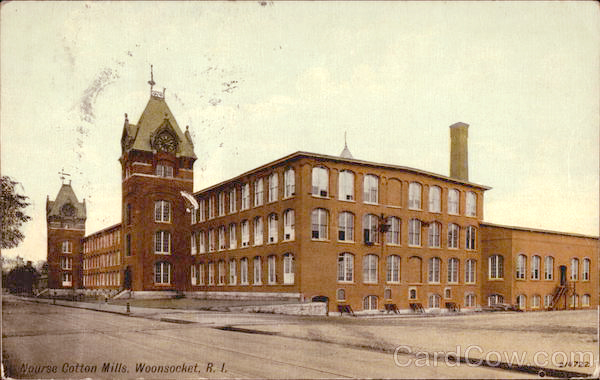Before the First World War, the Social and Nourse Mills were operated as a single unit. Lines often ran 52 weeks per year on a single product, often for a single customer. Finishing and styling was done in-house, and products were distributed through an in-house sales office in New York.
While production for the war effort was an economic boon for mill owners and employees alike, the period was short lived. The end of government contracts and foreign exports, along with a growing southern cotton industry caused textile companies in the northeast to suffer. In 1926, management called for layoffs and wage cuts. In responsoe, employees staged a walkout demanding shorter hours, reduced production, and higher wages. Unable to find a compromise, the Nourse Mill closed in November 1926.
In 1927, the property was purchased by the Manville Jenkkes Company who invested $2 million and reopened the building as the Woonsocket Rayon Company. Woonsocket Rayon would face its own challenges with organized labor.
In 1933, with the passage of President Roosevelt's National Recovery Act (NRA), Woonsocket’s largest union - the Independent Textile Union (later the Independent Trade Union) was poised for tremendous growth. While the Great Textile Strike of 1934 was called by the Amalgamated Textile Union, ITU members walked off the job in support of the ATW's actions. However, the Woonsocket Rayon Company refused to close during the strike claiming that it was difficult to shut down the complicated machines.
The mill's failure to close caused workers to riot in the streets and the National Guard was called. On the evening of September 12, Governor Green addressed the crowd on the radio urging them to disperse. Instead, the crowd grew. By midnight a group of 500 began hurling rocks at police, who responded with tear gas. As word of the altercation spread the crowd grew to 2,000. In an effort to push back the crowd, the National Guard fired 30 shots, hitting four and killing two. The shooting did not have the effect the National Guard had hoped. Instead, the riot swelled to a mob of 8,000 men, women, and children. Two more companies of National Guardsmen arrived and the city was put under military rule until order could be restored.
Woonsocket Rayon did manage to survive the fallout from the riot and was eventually purchased by Textron. However, the company was closed permanently in 1949.
<i>The building would be destroyed by a fire in 1956. Images courtesy of the Rhode Island Historical Society (A) and the Harris Public Library (B & C)</i>
